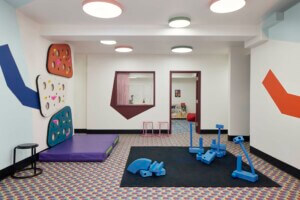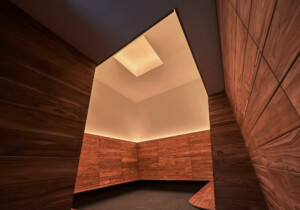With the debate around gun control raging after the February 14th shooting in Parkland, Florida, President Trump and the National Rifle Association (NRA) have been banging on alternative solutions to prevent mass shootings in schools, from arming teachers to hardening the schools themselves. But if the NRA had their way, what would the school of the future look like? Judging from the design guidelines that came out of their 2013 National School Shield Task Force report, they’d likely resemble prisons.
The 2013 report was commissioned by the NRA in response to the Sandy Hook shooting at the end of 2012, and apart from advocating for school safety plans, the task force’s findings at times come closer to recommendations for bunkers. Ironically, Sandy Hook School reopened in 2016 with a focus on “passive security” and the healing serenity of nature, presenting a diametrically different vision of school design.
Playgrounds and the rest of the school would need to be surrounded by a perimeter fence with select entrance points, and to ensure that potential shooters couldn’t cut through it, all vegetation would need to be stripped from the area. Trees and shrubs provide “hiding places for people, weapons, and explosive devices, blocking lighting, inadvertently providing routes of unauthorized access,” though the report notes that trees aren’t useless; they can “provide a level of blast shielding” in the case of an explosive threat.
Being able to view the planted landscape from the inside isn’t much of a concern, as the report recommends shrinking, removing, or barring over vulnerable windows to prevent attackers from breaching them. Ideally, schools would retrofit their windows with bulletproof glass and retain the ability to surveil the surrounding area, but with ballistic glass costing around $100 per square foot, it seems more likely that they’d just do away with them altogether.
Parking lots would be heavily rejiggered, with a focus on breaking up the large swaths of asphalt into heavily surveilled parking “islands.” While it might be convenient for students and teachers to park near the school, the NRA notes “vehicles can provide potential attackers with a means of concealing and transporting weapons, can be used as a tool in overpowering physical security infrastructure, and can even serve as weapons in and of themselves.”
Entrance doors made from bulletproof glass at the reception area for trapping attackers, rigging the building with security cameras and reconfiguring school floor plans to resemble a panopticon are all on the list, and seem more like recommendations for designing a military base than anything else. The NRA suggests funding these upgrades through federal grants, but with schools across the country unable to afford heat in the winter, and teachers striking for higher wages, it seems unlikely that this would happen.
In that case, the report recommends students and teachers “hide and hope” if there’s a shooting. It remains to be seen whether the 150 schools that an NRA spokesperson said accepted help from the organization to fortify their schools are any safer. One guess is, probably not.











